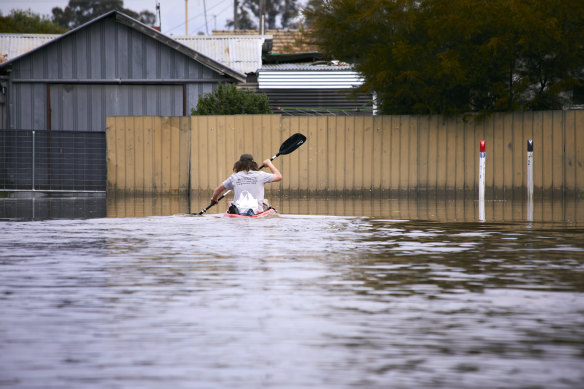- Exclusive
- Politics
- Victoria
- Victorian budget
This was published 1 year ago
Water retailers pleaded to borrow $36.5 million extra in debt blowout
By Rachel Eddie
Four water retailers serving regional homes were forced to make last-minute pleas to borrow a combined extra $36.5 million last year to deal with floods and infrastructure blowouts.
The increases in borrowing limits, approved by Victorian Treasurer Tim Pallas in June, were detailed in a ministerial briefing provided to the state opposition under freedom of information and obtained by The Age.
The government sets a cap on how much each corporation can borrow for the coming financial year each June to ensure the retailers are financially stable and can offer affordable prices.
But the document shows that four regional water companies – Wannon Water, Lower Murray Water, East Gippsland Water and Goulburn Valley Water – were so cash-strapped in 2022-23 they had to go back for permission to borrow more money, just as the financial year was coming to an end.
One of the corporations had its borrowing limit almost doubled in the final month of the last financial year, and two risked being unable to meet their obligations if they could not take on more debt.
The corporations all operated at a loss last financial year, but the Department of Treasury and Finance’s briefing notes said they all had capacity to service the borrowings.
Dr Erin O’Donnell, a senior lecturer in water law and policy at the University of Melbourne Law School, said regional water corporations in Victoria were unable to act independently and plan ahead because of government-imposed constraints.
She said the need to go back for approval to borrow more would take up time and money.
“It shows that they’ve got an inability to really plan ahead and to build a buffer around these kinds of predictable additional costs,” O’Donnell said.
Two of the corporations blamed the 2022 floods, which escalated maintenance costs but decreased how much water was sold.
“Floods – we know they’re only going to get worse,” O’Donnell said. “[The entities] need to be able to respond to these extremes, and they kind of need to do it without being forced to go cap in hand to the Department of Treasury and Finance.”
The corporations borrow through the Treasury Corporation of Victoria, which charges them interest.
In the briefing document, the Department of Treasury and Finance last year said Goulburn Valley Water might be unable to meet its obligations for the year if its borrowing limit wasn’t increased from $19 million to $29 million because of the floods.
Goulburn Valley Water managing director Steve Capewell said the company was in a stable position despite the impact of the “extraordinary and unprecedented” 2022 floods and La Nina weather pattern.
“We only drew down $3 million of the $10 million increase in the approved limit; it turned out to be an overly conservative request,” Capewell said in a statement.

A flooded street in Shepparton in October 2022.Credit: Louis Trerise
Wannon Water almost doubled its borrowing limit from $19 million to $37.5 million for 2022-23 last June to deal with cost overruns on the Warrnambool Sewage Treatment Plant upgrade, which it blamed on global construction pressures and a shortage of specialist contractors in the regions.
A company spokeswoman said the upgrade, which has more than doubled in price from $37 million to $85 million, was Wannon Water’s biggest ever infrastructure project.
“The initial total project cost estimate was forecast and independently verified nearly seven years ago, reflecting the market at the time,” she said.
“Wannon Water’s strong financial position allowed us to borrow money to help fund the additional costs. The sewage treatment plant is a long-lived asset, so it’s prudent that we pay the cost off over the life of the plant.”
The project was originally included in customer prices set for 2018-23 by the Essential Services Commission. Customers will pay off the extra cost over the life of the facility.
Treasury was also concerned Lower Murray Water would be unable to meet its obligations for 2022-23 if its borrowing limit was not increased from $8 million to $14 million because of the floods.
A company spokesman said Lower Murray Water was financially stable and debt was used to manage peaks and troughs in expenditure. He said investments would now ensure customers received safe and reliable water supply into the future.
East Gippsland Water had its borrowing limit increased from $3 million to $5 million to fast-track urgent investment in the Paynesville Water Recycling Plant, to address concerns with its performance and environmental compliance.
East Gippsland Water acting managing director Neville Pearce also said the company was stable and investments would prepare for the region’s growing population and climate change.
The Age has previously revealed Pallas took a combined $214 million from four different Melbourne-based water corporations in what is known as “capital repatriation” in 2022-23, on top of dividends they paid to the government as a shareholder.
Opposition finance spokeswoman Jess Wilson said Labor couldn’t manage money.
“Whether it’s water corporations, hospitals or government departments, Labor continues to shift its record debt onto agencies which only results in poorer outcomes for Victorians,” Wilson said.
Water prices for all customers have been set until 2028 and a state government spokeswoman said Victorians’ water bills were among the lowest in Australia.
“These prices are set by the independent Essential Services Commission and ensure water corporations can continue providing affordable water for their customers into the future,” she said.
Start the day with a summary of the day’s most important and interesting stories, analysis and insights. Sign up for our Morning Edition newsletter.